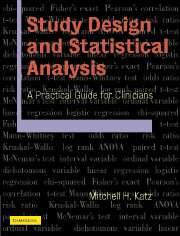Book contents
- Frontmatter
- Contents
- Preface
- 1 Introduction
- 2 Designing a study
- 3 Data management
- 4 Univariate statistics
- 5 Bivariate statistics
- 6 Multivariable statistics
- 7 Sample size calculations
- 8 Studies of diagnostic and prognostic tests (predictive studies)
- 9 Statistics and causality
- 10 Special topics
- 11 Publishing research
- 12 Conclusion
- Index
5 - Bivariate statistics
Published online by Cambridge University Press: 05 August 2012
- Frontmatter
- Contents
- Preface
- 1 Introduction
- 2 Designing a study
- 3 Data management
- 4 Univariate statistics
- 5 Bivariate statistics
- 6 Multivariable statistics
- 7 Sample size calculations
- 8 Studies of diagnostic and prognostic tests (predictive studies)
- 9 Statistics and causality
- 10 Special topics
- 11 Publishing research
- 12 Conclusion
- Index
Summary
How do I assess an association between two variables?
There are more than 10 commonly used statistics for demonstrating an association between two variables. But have no fear! Choosing the correct one is not difficult. You choose the bivariate statistic based on: (1) the type of risk factor and outcome variable you have; and (2) whether the data are unpaired or paired (repeated observations or matched data). Bivariate statistics for unpaired data are shown in Table 5.1. Bivariate statistics for repeated observations and matched data are shown in Tables 5.22 and 5.28 and discussed in Sections 5.10 and 5.11.
How do I assess an association between two dichotomous variables (comparison of proportions)?
The most commonly used tests for the association between two dichotomous variables with unpaired data are the chi-squared test and Fisher's exact test.
It is easiest to follow these tests if you think of them in terms of a two-by-two contingency table (also referred to as a cross tabulation table) as shown in Table 5.2. (It is called a two-by-two table because it has two rows and two columns.)
In a two-by-two table, each subject will fall into one of the four cells – labeled a, b, c, d – depending on that subject's values on the risk factor and the outcome. The column totals (a + c and b + d) and the row totals (a + b and c + d) are referred to as marginal totals.
Information
- Type
- Chapter
- Information
- Study Design and Statistical AnalysisA Practical Guide for Clinicians, pp. 66 - 119Publisher: Cambridge University PressPrint publication year: 2006
Accessibility standard: Unknown
Why this information is here
This section outlines the accessibility features of this content - including support for screen readers, full keyboard navigation and high-contrast display options. This may not be relevant for you.Accessibility Information
- 2
- Cited by
